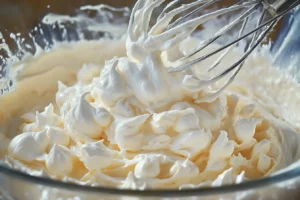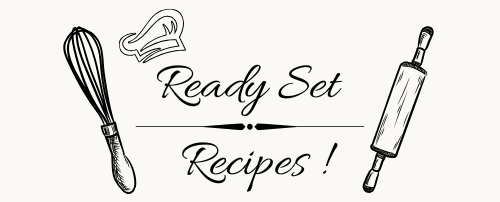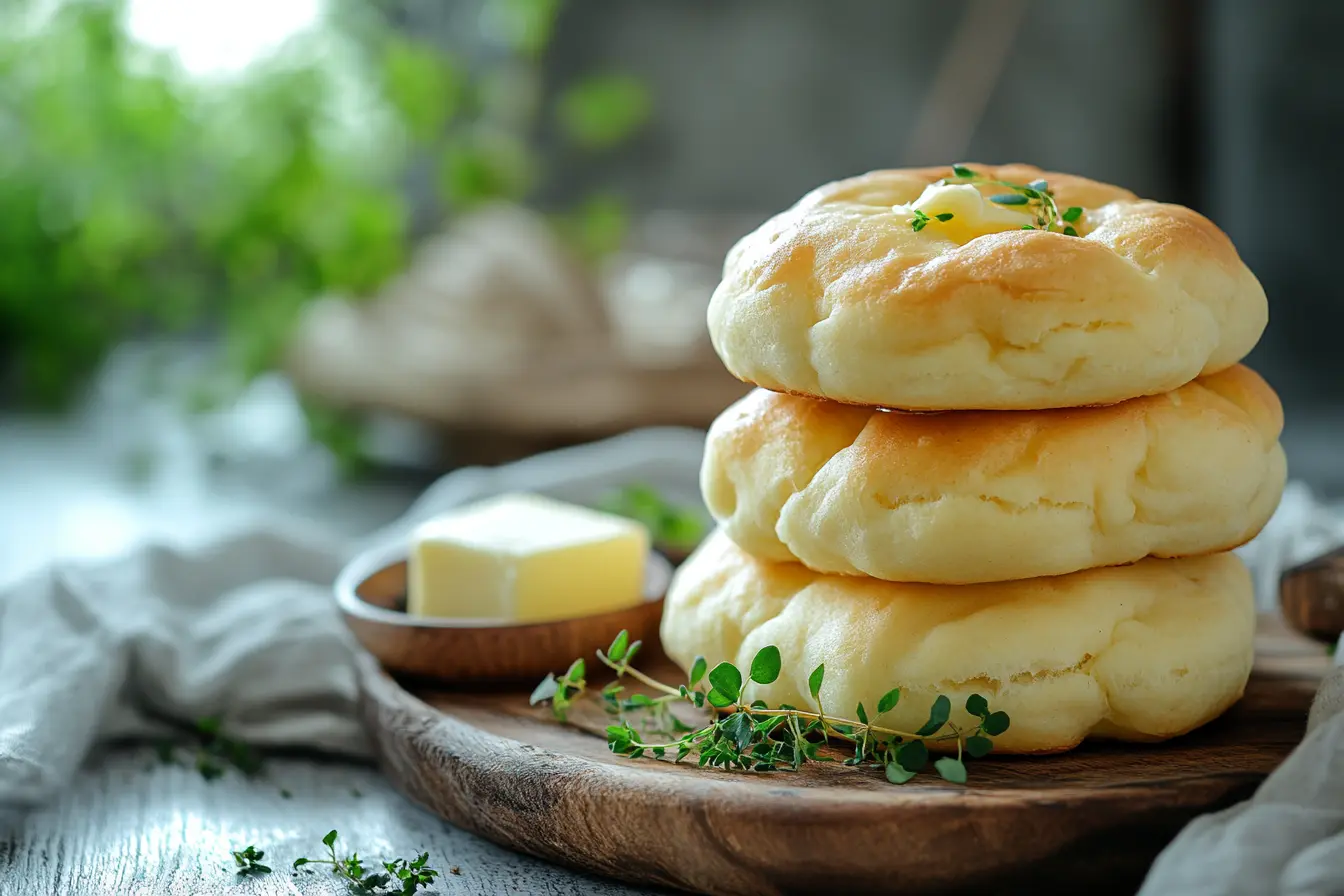Ever craved a bread that’s airy, delicious, and guilt-free? Meet Cloud Bread—a fluffy, low-carb, and gluten-free alternative that’s taken the internet by storm! This no-flour, high-protein bread is made with just a few simple ingredients yet delivers an incredibly soft and satisfying texture.
Whether you’re following a keto-friendly diet, looking for a healthy bread substitute, or just want to try the viral TikTok sensation, this guide has you covered. We’ll dive into the origins of Cloud Bread, how to make it, explore tasty variations, uncover its nutritional benefits, and answer the most commonly asked questions. Ready to get baking? Let’s jump right in!
Understanding Cloud Bread – A Comprehensive Guide
What Is Cloud Bread?
Cloud Bread isn’t your average loaf. It’s a soft, airy bread substitute made primarily from whipped egg whites, lending it a cloud-like texture. Unlike traditional bread, it’s completely gluten-free and can be tailored to fit various dietary needs, from low-carb to keto-friendly.
This bread gained massive popularity online, particularly on social media, where users showcased its puffy, golden texture and simple three-ingredient recipe. It’s perfect for sandwiches, snacks, or even a base for creative recipes.
The Origins and Popularity of Cloud Bread
Despite its recent fame, Cloud Bread isn’t new. It traces its roots back to the Atkins diet era in the 1970s when people sought low-carb alternatives to traditional bread. However, it wasn’t until TikTok and Instagram users rediscovered it that it truly went viral.
The internet’s love for visually pleasing and diet-friendly recipes fueled the trend, making it a go-to for those wanting a light, satisfying alternative to bread without the extra carbs.
Key Characteristics of Cloud Bread
So, what makes Cloud Bread special?
- Fluffy and Airy Texture – Unlike dense traditional bread, it has a light, cloud-like consistency.
- Gluten-Free and Low-Carb – Perfect for diet-friendly meal plans like keto and paleo.
- Minimal Ingredients – Typically made with egg whites, cream of tartar, and a touch of sugar or cornstarch.
- Versatile – Can be made sweet or savory with different seasonings and flavor additions.
How to Make Cloud Bread at Home
Essential Ingredients for Cloud Bread
 Before you start, gather your ingredients. Cloud Bread is incredibly simple to make, yet getting the right balance is key to achieving that light, fluffy texture. Here’s what you’ll need:
Before you start, gather your ingredients. Cloud Bread is incredibly simple to make, yet getting the right balance is key to achieving that light, fluffy texture. Here’s what you’ll need:
- 3 large egg whites – They form the structure of the bread.
- 1 tablespoon cornstarch or almond flour – Helps stabilize the batter and create a soft texture.
- 1 tablespoon sugar or a sugar substitute – Adds a slight sweetness, but you can omit it for a savory version.
- ¼ teaspoon cream of tartar – This is essential for stiff peaks and maintaining the airiness.
Step-by-Step Preparation Process
Making Cloud Bread is all about technique. Follow these steps closely to ensure the best results.
- Preheat and Prepare – First, preheat your oven to 300°F (150°C). Line a baking sheet with parchment paper to prevent sticking.
- Whip the Egg Whites – In a clean, grease-free bowl, beat the egg whites using an electric mixer. When they become foamy, add the cream of tartar and continue beating.
- Incorporate the Dry Ingredients – Slowly sprinkle in the sugar and cornstarch, beating continuously until stiff peaks form. This step is crucial—your mixture should hold its shape without collapsing.
- Shape the Cloud Bread – Using a spoon or spatula, gently scoop the batter onto the baking sheet, forming small round mounds about 1 inch apart.
- Bake to Perfection – Place in the oven and bake for 25-30 minutes or until the tops turn golden brown. The inside should remain soft and airy.
- Cool and Enjoy – Let the Cloud Bread cool for at least 10 minutes before peeling it off the parchment paper. This helps maintain its structure.
Tips for Achieving the Perfect Fluffy Texture
 Use room-temperature eggs – They whip up faster and hold more air.
Use room-temperature eggs – They whip up faster and hold more air.- Don’t overmix – Once stiff peaks form, stop beating. Overmixing can deflate the batter.
- Be gentle when folding in ingredients – Stirring too hard can knock the air out, making the bread dense.
- Bake immediately – If you let the batter sit too long, it will lose its fluffiness.
Exploring Variations of Cloud Bread Recipes
Sweet Cloud Bread Variations
Although Cloud Bread is naturally light and neutral in flavor, adding a touch of sweetness can take it to another level! If you love desserts but want to stay low-carb, these variations are perfect.
- Vanilla Cloud Bread – Add ½ teaspoon of vanilla extract and a sprinkle of powdered sweetener for a subtly sweet flavor.
- Cinnamon Swirl Cloud Bread – Mix in ½ teaspoon of cinnamon and a dash of nutmeg to give your bread a warm, spiced aroma.
- Chocolate Cloud Bread – Incorporate 1 tablespoon of cocoa powder and a little extra sweetener for a light, fluffy chocolate treat.
- Berry-Infused Cloud Bread – Gently fold in freeze-dried raspberries or blueberries before baking for a fruity twist.
Savory Cloud Bread Options
If you prefer something on the savory side, you’re in luck! Cloud Bread works beautifully as a substitute for buns, wraps, or even mini pizzas. Here are some tasty ways to spice it up:
- Garlic & Herb Cloud Bread – Stir in ½ teaspoon of garlic powder and dried Italian herbs before baking.
- Cheese Cloud Bread – Sprinkle grated Parmesan or shredded cheddar into the batter for an irresistible cheesy bite.
- Everything Bagel Cloud Bread – Add “Everything but the Bagel” seasoning for a flavorful, toasty crunch.
- Sun-Dried Tomato & Basil Cloud Bread – Mix in finely chopped sun-dried tomatoes and fresh basil for a Mediterranean-inspired twist.
Incorporating Different Flavors and Additives
Beyond the sweet and savory options, there are countless ways to customize Cloud Bread. If you want more texture, you can fold in chia seeds, flaxseeds, or crushed nuts. For a protein boost, try adding a spoonful of unflavored protein powder.
Additionally, if you’re making keto cloud bread, you can swap the sugar for a low-carb alternative like monk fruit or erythritol.
Nutritional Information and Health Considerations
Caloric Content and Macronutrient Breakdown
If you’re watching your diet, you’ll be happy to know that Cloud Bread is incredibly low in calories and carbs. Because it doesn’t contain traditional flour, it’s a great choice for those following a low-carb, keto, or gluten-free diet.
On average, a single piece of Cloud Bread (made with the classic recipe) contains:
- Calories: ~35-50
- Protein: 3-5g
- Fat: 2-3g
- Carbohydrates: <1g
Potential Health Benefits of Cloud Bread
Because of its unique composition, Cloud Bread offers several health benefits, especially for those looking to reduce carbs or avoid gluten.
- Supports Low-Carb Diets – Since Cloud Bread contains almost no carbohydrates, it’s perfect for keto and paleo eating plans.
- Gluten-Free Alternative – People with gluten sensitivities or celiac disease can enjoy this bread without worry.
- High in Protein – The egg whites provide a solid protein boost, which helps with muscle maintenance and satiety.
- Easier to Digest – Unlike heavy, flour-based breads, Cloud Bread is light on the stomach and less likely to cause bloating.
💡 Bonus Tip: If you want to make Cloud Bread even healthier, swap regular sugar for a sugar substitute like monk fruit, stevia, or erythritol.
Dietary Considerations and Allergen Information
Although Cloud Bread works for many diets, it’s not for everyone. If you have egg allergies, this recipe isn’t suitable unless you use an egg-free substitute like aquafaba. Additionally, some versions include dairy, which may not be ideal for those who are lactose intolerant.
However, since Cloud Bread is free from grains, nuts, and soy, it’s safe for many restrictive diets. Just be sure to check any add-ins if you’re making flavored variations.
Serving Suggestions and Pairings for Cloud Bread
Ideal Meals and Dishes to Accompany Cloud Bread
Since Cloud Bread is incredibly light, fluffy, and versatile, it works well in a variety of meals. Whether you’re craving something sweet or savory, there’s a perfect way to enjoy it!
- Breakfast Delight – Use Cloud Bread as a base for avocado toast, topped with eggs, smoked salmon, or cream cheese.
- Low-Carb Sandwiches – Swap out traditional sandwich bread and layer it with turkey, grilled chicken, or fresh veggies for a healthier lunch.
- Burger Buns – Want a low-carb burger? Cloud Bread makes an excellent alternative to regular burger buns while keeping things light.
- Mini Pizzas – Spread tomato sauce, sprinkle cheese, and bake for a few minutes to create quick and easy low-carb pizzas.
Creative Uses of Cloud Bread in Recipes
If you’re looking for fun ways to incorporate Cloud Bread, try these unique ideas:
- Dessert Base – Drizzle honey or melted dark chocolate over a warm piece for an instant treat.
- Cloud Bread Chips – Slice, toast, and season with sea salt to make crispy, low-carb chips.
- French Toast Alternative – Dip in an egg-cinnamon mixture and pan-fry for a delicious low-carb breakfast option.
- Taco Shells – Fold warm Cloud Bread around seasoned meat and veggies for a gluten-free taco experience.
Storage and Reheating Tips
Unlike regular bread, Cloud Bread doesn’t have preservatives, so it needs proper storage to stay fresh.
- Room Temperature: Store in an airtight container for up to 2 days.
- Refrigeration: For longer storage, keep it in the fridge for up to 5 days.
- Freezing: If you want to make a big batch, freeze individual pieces with parchment paper between them for up to 2 months.
To reheat, simply pop it in the toaster, oven, or microwave for a few seconds to bring back its light, airy texture.
Frequently Asked Questions
What Is the Texture of Cloud Bread?
Many people wonder, “Does Cloud Bread feel like regular bread?” The answer is yes and no. While it looks like traditional bread, it’s actually much softer, airier, and slightly spongy. Since it’s made from whipped egg whites, the texture is closer to a soufflé or meringue rather than a dense loaf.
Can Cloud Bread Be Made Without Dairy?
Absolutely! Although some recipes include cream cheese or Greek yogurt, you don’t need dairy to make Cloud Bread. Simply stick to egg whites, cream of tartar, and cornstarch for a 100% dairy-free version.
How Should Cloud Bread Be Stored?
Storage is simple, but it’s essential to keep Cloud Bread fresh:
- At room temperature, it lasts 2 days in an airtight container.
- In the refrigerator, it stays good for up to 5 days.
- If freezing, separate layers with parchment paper and store for up to 2 months.
When you’re ready to eat it, just toast, bake, or microwave for a few seconds to restore its soft, airy texture.
Is Cloud Bread Suitable for a Ketogenic Diet?
Yes! Cloud Bread is a fantastic option for keto dieters since it’s virtually carb-free. However, if you’re strict about avoiding all sugars, replace regular sugar with keto-friendly sweeteners like monk fruit or erythritol.
What Are Common Mistakes to Avoid When Making Cloud Bread?
- Overmixing the Egg Whites – Once stiff peaks form, stop mixing! Otherwise, the batter may deflate.
- Not Using Cream of Tartar – This ingredient is essential for stabilizing the egg whites.
- Baking at the Wrong Temperature – Too hot, and it burns. Too low, and it stays wet inside. Stick to 300°F (150°C) for best results.
Can Cloud Bread Be Frozen for Later Use?
Definitely! Just place pieces in a freezer-safe bag with parchment paper in between. When you’re ready to enjoy, let it thaw at room temperature or reheat in the toaster or oven.

